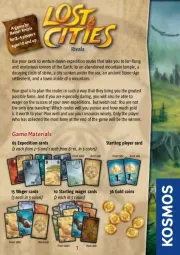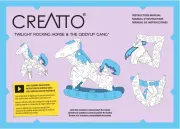Thames & Kosmos Kerala Handleiding
Bekijk gratis de handleiding van Thames & Kosmos Kerala (4 pagina’s), behorend tot de categorie Niet gecategoriseerd. Deze gids werd als nuttig beoordeeld door 2 mensen en kreeg gemiddeld 4.5 sterren uit 1.5 reviews. Heb je een vraag over Thames & Kosmos Kerala of wil je andere gebruikers van dit product iets vragen? Stel een vraag
Pagina 1/4

Front
Back
Kirsten Hiese
Welcome to the elephant festival in the Indian province of Kerala!
Colorfully decorated elephants parade around everywhere. The
celebration is alive with color and music. As part of the festival, you
want to make the most beautiful festival platform, displaying as many
elephant symbols as possible. Round by round, you will expand your
festival platform with tiles, placing one new tile per turn and moving
one of your two elephant figures onto it from an adjacent tile. Your
two elephant figures dictate where you can place a new tile. A tile can
also be placed on top of another tile. Watch out for your rival platform
builders. They can foil your plans by grabbing highly sought after tiles
before you can get them.
Each player builds their own festival platform with colored tiles.
At the end of the game, you want to have only one continuous area of
each color; otherwise, you will . (Note: For your own color, lose points
you can have two areas.) Also each missing color subtracts points.
You will gain points for each elephant symbol on your festival platform.
Some tiles have more than one symbol on them. The game ends when
the bag of tiles is empty. The player with the most points wins.
For 2-5 players, ages 8 and up
Game tiles ( in each of the colors)
Back
Scoring pad
each of the colors)
In addition you will need a pen or pencil, which is not included.
- Each player gets 2 elephant figures start tile of the same and a
color. With fewer than 5 players, place the unused elephant figures
and unused start tiles back into the box.
- Each player places his or her start tile with the elephant symbol
face up in front of them. Your start tile is the beginning of your
festival platform.
- Each player puts his or her two elephant figures on his or her
start tile.
- Depending on the number of players, you may have to remove a
certain number of the 100 game tiles place them back in and
the box:
- For 2 players, remove 20 random tiles. The tiles that are removed
should not be the same color as either of the players’ colors!
- For 3 players, remove . The tiles that are removed 10 random tiles
should not be the same color as any of the players’ colors!
- For 4 players, remove . The tiles that are removed 4 random tiles
should not be the same color as any of the players’ colors!
- For 5 players, do not remove any tiles. You will play with all 100
tiles.
- Place all of the tiles in play into the fabric Place the bag in the bag.
center of the table.
- Set one score card from the scoring pad aside. You will not need it
until the end of the game.
GAME OVERVIEW
GAME OBJECTIVE
GAME MATERIALS
GAME PREPARATION
Start tiles ( in each of the colors)
Example with 3 players: Blue, black, and red
10 random tiles that are not blue, black, or red are removed
accordingly.
These 10
tiles are
removed
Example: Setup for five players
1
/
/
/
/
2
Front

The game is played over several rounds. The youngest player starts and is
given the bag of tiles.
First, he or she draws the same number of tiles from the bag as the
number of players. For example, if there are five players, the starting
player draws five tiles from the bag. Lay the tiles that were drawn face
up in the center of the table.
The first player must select one tile and place it orthogonally adjacent
to his or her start tile, aligned with one of the start tile’s four sides.
“Orthogonally adjacent” means lined up next to each other vertically or
horizontally, not diagonally.
The player then moves from his or her one of their elephant figures
start tile to the This ends the player’s turn. new tile.
Now the player to the left of the starting player chooses from the
remaining tiles. This player places the chosen tile adjacent to his or her
start tile and moves one of his or her elephant figures onto the tile.
This continues until the last player of the round takes the last tile and
adds it to his or her platform. At this point, the round ends.
The next round starts when the starting player passes the bag of tiles to
the player to his or her left
.
Next Rounds
The rounds continue in the same manner, with the player that has the bag
of tiles pulling out as many tiles as players then placing them face up in the
center of the table. The players then each choose a tile, place it adjacent to
another tile, and move one of their elephants.
Passing
Two times during the game you have the ability to pass (in other words,
to skip your turn). If you pass, you do not take any tiles from the
center of the table. You lay one of your elephant figures on its
side. If you have placed both of your elephant figures on their
sides, you may not pass. When players pass, the unchosen tiles
remain in the center of the table until the end of the round. Then
at the end of the round the extra tiles are placed back in the box.
Important: You can still move an elephant figure from tile to tile as
usual after it has been placed on its side. Laying the figures on their
sides just helps keep track of the number of passes taken.
GAME PLAY
OTHER RULES
Example: You are playing with four other players and have pulled
these tiles out of the bag.
Example: The blue player chooses the black tile with three elephant
symbols and places it next to her start tile. She then moves one of her
elephant figures onto that tile.
1
2
3
Placement Rules
When it is your turn, choose from the center of the 1 tile
table. You must place this tile orthogonally adjacent to one
of the two tiles with your on them. Then elephant figures
move the elephant figure onto the newly placed tile!
Example: Later in the game, the blue player has taken the
green tile with two elephant symbols. She places the tile
next to the black tile which has one of her blue elephant
figures on it. She then move the elephant figure from the
black tile to the new green tile.
Example: Later in the game, the blue player has chosen the green tile
with three elephant symbols on it. She places it on top of the black tile
with two elephant symbols. Then she moves her elephant onto the
newly placed tile.
Note: Only 1 elephant figure can be on a tile at a time. The only
exception is at the start of the game, when two elephants are on your
start tile. Placing tiles on top of other tiles may enable you to reconnect 2
separate areas, creating a single larger area of the same color.
Overlaying
You can place a tile on top of an already-placed tile. You can do this
multiple times. However, the tile must be placed adjacent to an elephant
figure and the elephant figure must be placed onto the new tile.
1
2 3
Newly placed tile

The Tiles
Tile with , , elephant symbols or
Tiles with elephant symbols get the same number of points as the
number of elephants depicted on them; i.e. 1, 2, or 3 points.
Special tile with colored edge
These tiles have a second color one edge along . At the end of
the game, if this edge is adjacent to a tile of the second color,
you receive 5 points. There is no penalty if the colored edge
is placed next to a non-matching color no tile is adjacent or to the
edge. However, the tile still counts as a tile of the primary color and you
may lose points if you have two separate areas of the same color.
Example: The blue tile with the black edge
is adjacent to a black tile. So, the player
would be awarded 5 points at the end of
the game.
Example: The blue player has placed a special move-elephant-
figure tile on the lower right of her festival platform. The blue player
then placed her elephant figure onto this tile. She then moves her
second elephant figure from the green tile to the purple tile.
Note: The elephant
figure depicted on this
tile does not count as an
elephant symbol and is
therefore not worth any
points at the end of the
game.
Special tile: move elephant figure
If you add a move-elephant-figure tile to your festival platform
and move your elephant figure onto it, you may immediately
move either of your elephant figures any tileto .
2
Example: The blue player has placed a special move-tile tile at the
bottom left of her festival platform and placed an elephant figure onto
it. The blue player then moves the purple tile to another location. The
blue player cannot move the tiles crossed out with black X’s because
they are either a) surrounded by other tiles and would create a hole, b)
an elephant figure is on the tile, or c) removing the tile would split the
platform into two parts. The purple tile is placed such that it does not
result in a split platform, hole, or diagonal-only connection.
Special tile: move tile
When the move-tile tile is added to your festival platform and
you move an elephant figure onto it, you may immediately
move a tile (or a whole stack of tiles) to another open spot
on your platform. However, there must be no elephant figure on the tile
or stack of tiles. You cannot move a tile or stack of tiles that is surrounded
by tiles on all four sides. When moving a stack of tiles, the whole stack
must be moved (you cannot move only the top tile) and the stack cannot
be rearranged. You cannot place the moved tile(s) on top of another tile;
only on an open spot, as defined by the regular tile placement rules. Also
you cannot split your platform into two parts by moving the tile(s). There
must be between tiles after moving.no hole or diagonal-only connection
Product specificaties
| Merk: | Thames & Kosmos |
| Categorie: | Niet gecategoriseerd |
| Model: | Kerala |
Heb je hulp nodig?
Als je hulp nodig hebt met Thames & Kosmos Kerala stel dan hieronder een vraag en andere gebruikers zullen je antwoorden
Handleiding Niet gecategoriseerd Thames & Kosmos

6 Augustus 2025

6 Augustus 2025

6 Augustus 2025

5 Augustus 2025

5 Augustus 2025
Handleiding Niet gecategoriseerd
- Jocel
- Earthwise
- Voltcraft
- Powerfix
- Kathrein
- YoLink
- SolidDrive
- Tecnoware
- WAGAN
- Contax
- APDTY
- Membantu
- Smart Media
- J5create
- Minkels
Nieuwste handleidingen voor Niet gecategoriseerd

15 September 2025

15 September 2025

15 September 2025

15 September 2025

15 September 2025

15 September 2025

15 September 2025

15 September 2025

15 September 2025

15 September 2025




